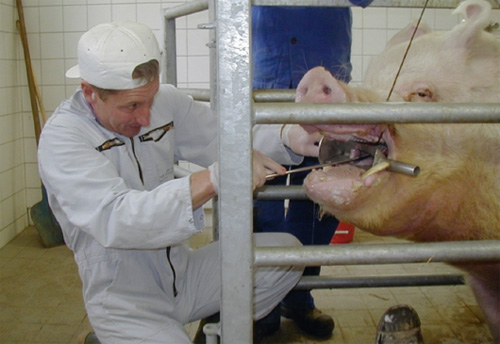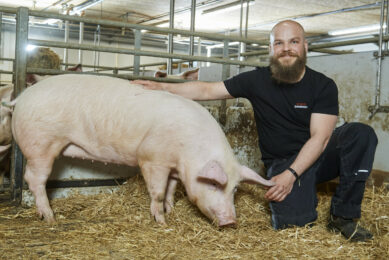How to eradicate atrophic rhinitis: A Dutch case study

For a long time, it hasn’t exactly been clear which pathogen caused growth retarding atrophic rhinitis in pigs. Since the toxin producing bacteria Pasteurella multocida has been identified as the major cause, the Netherlands has managed to follow a path towards gradual eradication through nationwide cooperation. Veterinarian expert Dr Marten de Jong talks about what is happening – and what still needs to be done.
“Atrophic rhinitis” – the name of the disease is not entirely correct, says Dr Marten de Jong. Rhinitis would suggest an inflammation of the nose – but in fact it is a toxin causing the problems. De Jong says, “Pasteurella rhinotoxicosis therefore would perhaps be better. But it’s hard to get rid of a name once it gets used by so many people.”
De Jong, 66, a well-known veterinarian and independent consultant, used to be associated with the Dutch Animal Health Service for over 25 years. He is known for his knowledge about the respiratory disease, which has been causing a lot of problems for many pig producers – and has been closely involved in the growing control and eradication. He has never stopped encouraging the Dutch livestock industry to pay more attention to the disease and prevent it wherever possible.
Pathogenesis
What is known as atrophic rhinitis is a deformation of the nose turbinates, cartilage and bones in younger pigs, caused by different dermonecrotoxins of Pasteurella and Bordetella bacteria.
The toxin produced by toxigenic strains of the bacterium Pasteurella multocida is harmful in favourable circumstances. P. multocida then starts to colonise and produce sufficient amounts of toxin to cause the economic lasting disease. Bordetella bronchiseptica, which is ubiquitary, can play an important role in the disease’s pathogenesis, and has even long been identified as the major cause of atrophic rhinitis in piglets less than three weeks of age. B. bronchiseptica causes inflammated mucosa in the nasal cavity, which is an ideal environment for P. multocidato grow rapidly.
“When there is a combination of both bacteria in piglets at a young age, disease will develop a lot easier,” De Jong explains. “In theory, however, P. multocida alone is sufficient to create the growth retarding and economically harmful atrophic rhinitis. An inflammation in the pig mucosa can be caused by many viruses and bacteria, and even by an abundance of ammonia in the air, so theoretically one wouldn’t need B. bronchiseptica.”As long as it is only present in relatively small numbers in porcine respiratory tracts, not colonising in sufficient numbers to cause disease, it’s a bacterium that is difficult to detect, De Jong adds. “The bacteria can exist latently for a very long time. Pasteurella multocida knows how to hide itself in the tonsils’ deepest crypts.” A good vaccine to deal with progressive atrophic rhinitis, would focus on both bacteria, says De Jong. “Of course it needs to create a strong antitoxic reaction to P. multocida. But it also needs to target B. bronchiseptica – to make sure there is a non-adherence reaction.”
Clinical signs
The majority of progressive atrophic rhinitis cases occur in growing pigs aged between three to six weeks of age. The disease can be recognised by sneezing, tear staining and nose bleeds in combination with growth retardation.
Atrophic rhinitis causes a shortened wrinkled pig’s nose due to bone deformations as the pig grows – and this will lead to a reduced growth of a pig’s upper jaw in comparison to its lower jaw. This makes feed intake painful and more difficult, which comes at a pig’s disadvantage during feeding as there is always a competition for feed in a weaner barn. De Jong adds, “On top of that, atrophic rhinitis damages the filter for the lungs, which causes the lungs to be more easily damaged. These pigs will be prone to develop pneumonia.” Last but not least, high amounts of toxin can also damage liver and kidney functions.
Banning progressive AR
With an integrated approach, the Netherlands is among the leading countries in keeping the disease under control. Profiting from the country’s relatively small size and organised infrastructure, over the years, a strong cooperation has come into existence between GGP and GP breeding organisations, the Animal Health Service and the Dutch Product Board for Meat and Livestock.
Jointly they developed a targeted approach to control progressive atrophic rhinitis in pigs.
Nationwide, the Animal Health Service is providing animal health programmes and laboratory testing facilities for e.g. the livestock industry, setting up a programme for testing different ages of breeding stock by PCR, helping GGP and GP breeding organisations only to sell material that is free of toxin producing P. multocida. The theory is that bringing in negative, vaccinated gilts in a positive sow herd, would lead to negative litters as immunity is transferred to their piglets through maternally derived antibodies in the colostrum. For many farms, after three to five years, when all sows have been replaced by fresh gilts, the herd ideally ought to be free from toxigenic P. multocida, after which vaccination can be finished.
In practice, however, some management and biosecurity awareness is paramount in order to avoid toxigenic P. multocida to creep through mazes in the system. For instance, gilts may become positive to P. multocida prior to vaccination. And since older gilts can be a carrier of P. multocidawithout actually developing disease, this could be a threat.
He continues, “On large breeding complexes with a finishing facility, a sow facility has therefore to be physically separated from the rest of the buildings to avoid cross contamination – infections cannot be permitted to enter from the finishing facilities back into the breeding facility.”
De Jong points out the danger of mixing pigs from older, positive sows with those from younger, negative gilts. “In addition, a strict all-in, all-out regime has to be applied. If animals are only put together from different age groups, it may already pose a danger.”
Taking all guidelines into account, however, the disease can be kept at bay and thus vaccine and antibiotic usage can be lowered, which is a bonus especially in Europe. If necessary, Bordetella is usually suppressed by using sulfogroups, Pasteurellais usually treated by using e.g. doxycyclines or penicillines.
The role of humans
It was a long road before it was possible to reach a status of control, De Jong says. “We often had to ask ourselves – how come the disease turns up every now and then again. Why do problems keep occurring at certain places? There must be a uniform cause.”
Man may play the last pivotal role in searching for causes, De Jong says – and it would pay off to test farm workers on toxigenic P. multocida contamination prior to hiring them. “Visiting various breeding farms for several years, there seems to be evidence that cross-contamination may occur through humans. It is known that about 30% of Dutch pig farmers are suffering from chronic bronchitis and thus may have an increased risk carrying toxin-forming P. multocidain their respiratory tract; some were even hospitalised. If they would e.g. spit on the floor in the pig pens, it may already be enough to infect the pigs.”
Since showering is not helpful in cleaning the human respiratory system, a two-way mouth cover may be a solution, De Jong says. “Not only one that filters the air that goes in, but also one that filters the air coming out.”
Control
Nowadays the disease does not pose a big threat in the Netherlands – it was taken off the list of notifiable diseases years ago. The developments have encouraged a range of other countries to go a similar way, as in Belgium, Austria, Germany and Switzerland, modified systems of the Dutch approach are being followed in order to come to a better nationwide approach to beat the disease.
In Denmark, a similar strong organised approach can be found as in the Netherlands; the Danish even say toxin-forming P. multocida is fully eradicated from its breeding stock. De Jong says, “The Danish have strongly focused on the development of the Specific Pathogen Free approach over the last couple of decades.” In the top of the breeding pyramid, corresponding with a red colour, pigs are 100% free of several diseases, such as Aujeszky’s Disease, scabies, swine dysentery, and atrophic rhinitis. The organised approach may have yielded success. In 1980, about 50% of breeding farms were positive for progressive atrophic rhinitis. Today Dutch GGP and GP breeders are 100% free and the production sites with over 99%.
For De Jong, however, this doesn’t mean that there is no room for improvement, as he is in favour of including slaughterhouses in the chain of awareness as well. “In my opinion, producers of finishers ought to be more aware of buying and producing healthy pigs as well. They turn to medicines or the needle too quickly. Therefore there should be a system where slaughterhouses can deduct an amount of money if they find any health problems. But unfortunately, too often, slaughterhouses are also keen to have the slaughterlines filled up.”Nowadays, however, producers do not feel this pressure (yet) and it is this liberty that keeps De Jong from saying the disease is 100% over in the Netherlands. “I am afraid that it may not have disappeared entirely,” De Jong says.
“Fellow veterinarians keep me updated about
farms and they also inform me about traditionally suspect farms when it comes to atrophic rhinitis. They sometimes tell me: I don’t know for sure but I may have seen the odd suspicious nose here or there…”
“Most often this deals with non-progressive atrophic rhinitis. This form increases in farms where piglets don’t get sufficient amounts of colostral antibodies against B. bronchiseptica, e.g. in large litters or in case of a lack of colostrum production. With the help of modern PCR techniques a precise diagnosis for these bacteria, as well as P. multocida, can easily be made.”











